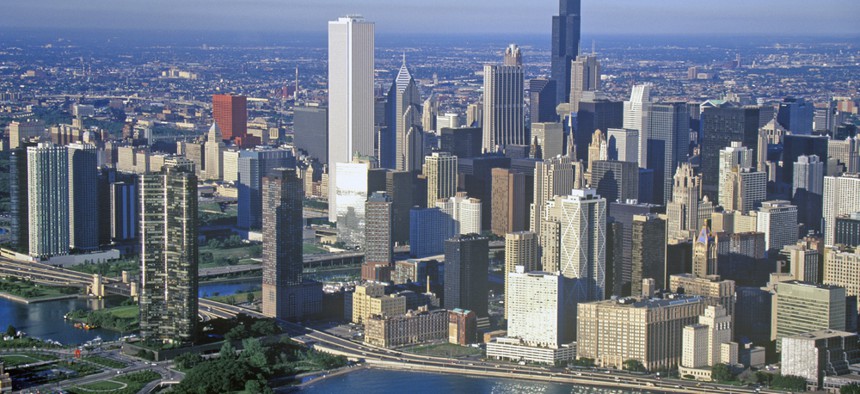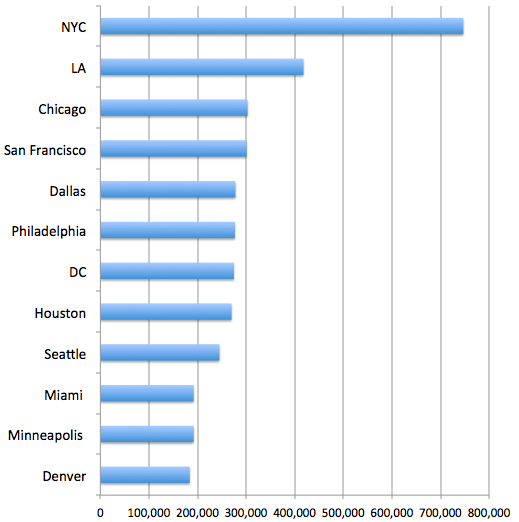The Feedback Loop That Will Make America's Richest Cities Even Richer

American Spirit / Shutterstock.com

Connecting state and local government leaders
Certain multisyllabic phrases—geographic sorting, economic agglomeration, cumulative advantage—are all fancy ways of saying smart young people move toward jobs and density.
This week, the Brookings Institution came out with a report on "job proximity"—that is, which cities have the largest and fastest-growing concentrations of jobs in their city centers. This is an important statistic, because people who live closer to work are more likely to be employed. It's particularly important for poorer workers who cannot afford longer commutes.
The key finding of the study was that people and jobs moved to the suburbs in the 2000s, and the number of jobs near the typical resident fell by 7 percent. This is in keeping with Trulia data that has found that most moves—both within counties (two-thirds of all moves) and between counties—are toward lower density and cheaper housing.
Even in a decade when retail gasoline prices tripled, people and work didn't move closer together. Americans are spacing out.
But another story emerges when you look at the cities with the highest job density and who is moving there. When Elizabeth Kneebone and Natalie Holmes used Census tracts to determine the places with the greatest job proximity, these cities topped the list:
Where the Accessible Jobs Are: The Number of Jobs Near the Average Resident in 2012, by City
Anybody who spends their free time looking at ordinal lists of American cities will notice that this is a pretty familiar set. It's almost exactly the list of the most populous U.S. metro areas (for methodological reasons, the Brookings study could not include Boston or any other cities in Massachusetts). It's almost exactly the list of the large U.S. cities with the highest median incomes. And the highest density of college grads . And the highest share of foreign-born residents among young people .
And, perhaps most importantly for the immediate future, it's almost exactly the list of cities where college grads have been moving since the recession began.
The Increase in Population of College Grads Between 2007 and 2012, by City

This is a tight feedback loop. The densest cities tend to be the most educated cities, which are also the richest cities, and often the biggest cities. They’re gobbling up a disproportionate share of college grads. And, as a result, they are becoming richer, denser, and more educated .
This feedback loop goes by many impressively multisyllabic names—geographic sorting, economic agglomeration, cumulative advantage. But they're all fancy ways to describe something simple. Even as older and less educated Americans are moving to the suburbs, young people with college degrees are moving toward density, and their migratory patterns are encouraging future young people to follow in their steps.
Is the sheer size of these cities’ educated workforce providing a kind of automatic marketing to new college grads? Or are denser cities just more productive, so they have more jobs to dangle in front of twentysomethings? Yes and yes, perhaps. Density and degrees have a magical relationship. Economists Edward Glaeser and Matthew Resseger have shown that in cities with lots of college grads, more-populous cities have more-productive workers. But the magic ends when you take away the degrees: Metro areas with fewer college grads show no relationship between population and productivity.
This week for me is bookended by two trips to New Orleans and Miami to look at and discuss economic opportunities and those cities. Both have good news. Despite its population decline, New Orleans has actually seen an increase in college grads moving to the city, greatly raising its share of bachelor’s degrees. According to 2012 Census figures, nearly a quarter of its adult population is under 34, more than New York or San Jose. Miami has the second-most-diverse Millennial cohort in the country and the number of young people living within three miles of its downtown has doubled in the last 10 years.
But many cities that don't already appear at the top of these degrees-and-density lists are fighting migratory currents that are pulling more of the most talented young people to the same small set of cities. “At the same time that American communities are desegregating, racially, they are becoming more segregated in terms of schooling and earnings," Enrico Moretti wrote in his book The Geography of Jobs. In other words, today's richest cities might not mimic the collapses suffered by the richest U.S. cities from the 1970s. "The knowledge economy has an inherent tendency toward geographical agglomeration," he wrote. "Initial advantages matter, and the future depends heavily on the past.”
( Image via American Spirit / Shutterstock.com )
NEXT STORY: Will a U.S. City Ever Host Another Olympics?





